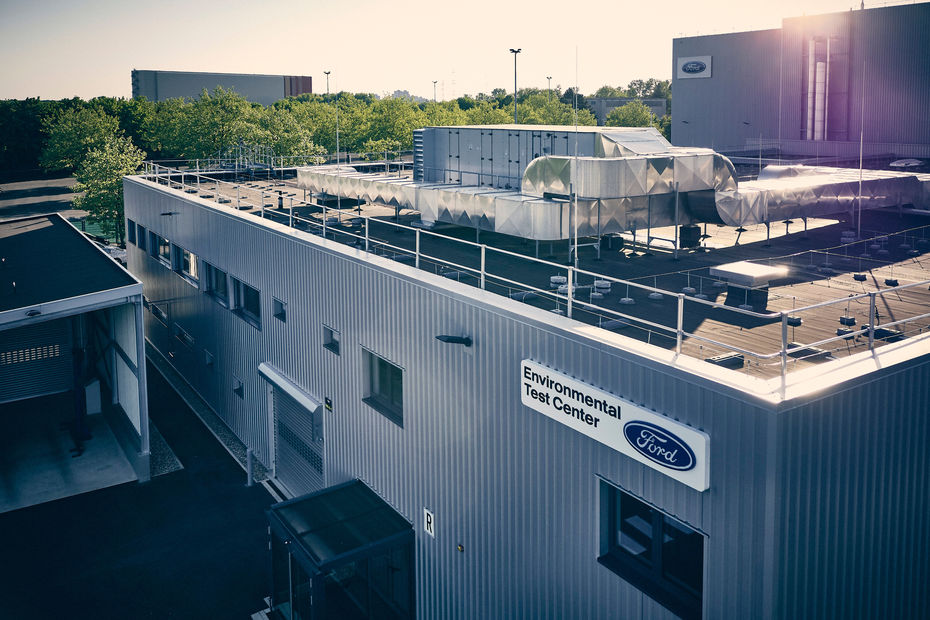
This May 16th, he falls of the ropes in the center of Cologne. Huge flashes tear the sky, the wind is unleashed, rain slams on the pavement of the forecourt of the station. No light filters through the thick clouds, the city is like diving into the dark. Yet a few kilometers away, in the district of Niehl, there is a place where the sun always shines and where the mercury rises to more than 30 degrees, with a humidity of 70%. This place is not a sauna or a recreational tropical bubble but one of the special pieces of a brand new building built on the huge industrial site of Ford : the “environmental testing center” of the American manufacturer, also nicknamed “Weather Factory”. A unit capable of recreating just about every existing climate to test the brand’s vehicles under a variety of conditions.
An investment of 70 million euros
This environmental center opened in May 2018 after three years of work. If this advanced equipment does not cost as much as a “real” production unit, Ford has still invested 70 million euros. Compared to 300 million euros injected into the neighboring factory for the production of the new Fiesta or 600 million invested in Saarlouis, not far from the French border, for the manufacture of Focus.

The creation of this “weather factory”, whose prime contractor is the American company specialized Jacobs, is a major “strategic decision” for Ford Europe, in the words of Michael Steup, who carried the project. The idea is to put a high-performance tool at the disposal of the various units of Ford Europe present in the vicinity: the design department, the development of new vehicles, teams specializing in engines, electronics, heating … D ‘ elsewhere, the site just open (its machines and software are still running), the booking schedule of test rooms is already full. “We receive calls from our colleagues every day, we have trouble responding to the request,” says Michael Steup. “Here we can test ten vehicles simultaneously, with rotations of two teams a day, 250 days a year”. About fifteen employees are dedicated to the preparation of vehicles and sixty to the use and maintenance of machines.
An altitude simulator
This type of equipment is not new (BMW and Volkswagen have had their environmental testing centers for at least two decades) but none brings together as many features as advanced as Ford’s. The center of Cologne has for example a laboratory capable of simulating the altitude, up to 5200 meters. This piece is a feat alone: the climb to altitude (it takes 7 minutes to “climb” from 0 to 5200 meters) puts a pressure of 5 tons on the walls. These are therefore particularly strengthened. A decompression chamber is necessary and it is obviously not advisable to venture unprepared in an environment close to the high mountains.


The “Weather Factory” has two other wind tunnels and three chambers where it is possible to vary the temperature (-40 to + 55 ° C), humidity, wind (up to 250 km / h); to make snow (it takes four hours to drop 20 centimeters of powder) and rain, to simulate all climatic situations. No site in the world can vary all these ingredients in one place to recreate, a few meters away, a desert, a rainforest, the pack ice …
This technological feat requires a burst of energy. The site consumes as much electricity as a city of 2400 inhabitants, 100% of renewable origin (Ford is supplied by RheinEnergie). To circulate the air, it has a huge turbine with a power of 1.2MW.

Field, studio or digital tests?
But all these efforts are not gadget or artifice to convince future customers of the robustness of the brand’s productions. Ford first emphasizes the “global” aspect of its production and recalls that half of its vehicles drive in countries whose roads exceed 1000 meters above sea level. The use of climate test benches would also make it possible to dispense with some of the tests in regions with extreme climates. Costly operations, subject to climatic hazards … and need to hide from the objectives of the paparazzi automobiles. The weather factory could thus be at the origin of savings but especially of a gain of efficiency. “That’s why we put it closer to our design teams in Europe,” explains Michael Steup.
As for the numerical simulation, it would not be advanced enough to cover all the cases treated in test benches. “We are still far from being able to do without tests in reality,” he said. But a hyper-controlled reality, where you can trigger a shower, a snow storm or a heat wave by pressing a few buttons (and make them stop as easily). Here is an acceptable compromise for the automobile demiurges while waiting for the whole “numerical simulation”.
